FolkWorld Issue 35 02/2008;
Article by Walkin' T:-)M
Folk Music on the Silver Screen (1)
You Ain't Heard Nothin' Yet - From the Silents to the Talkies
Music and film are siblings which cannot be separated. There is only a
handful of movies that have no music at all. Music creates a
certain mood, it builts up suspense and it increases the impact of images.
Besides the big orchestral scores, folk songs and traditional dance music
allude to particular eras and localities. Believe it or not, the story
of Folk Music on the Silver Screen already began in the infancy of moving pictures -
when the world was black-and-white and silent.
The audience in the basement lounge of the Salon Indien du Grand Café on the
Boulevard des Capucines in Paris did probably not realize that it was watching an
historical moment. It was the 28th December 1895 and the date that is usually
refered to with showing the first moving pictures to a paying public.
Louis and Auguste Lumière's
 presentation featured ten short films,
each about 17 meters long, which runs approximately 38 to 49 seconds.
Their actualités such as
La Sortie de l'Usine Lumière à Lyon [Exit from the Lumière Factory in Lyon, France 1895]
were rudimentary documentaries, while the slapstick of
L'Arroseur Arrosé
[The Gardener or the Sprinkler Sprinkled, France 1895] anticipated the comedy film.
presentation featured ten short films,
each about 17 meters long, which runs approximately 38 to 49 seconds.
Their actualités such as
La Sortie de l'Usine Lumière à Lyon [Exit from the Lumière Factory in Lyon, France 1895]
were rudimentary documentaries, while the slapstick of
L'Arroseur Arrosé
[The Gardener or the Sprinkler Sprinkled, France 1895] anticipated the comedy film.
These films were recorded with a cinématographe,
a three-in-one device that could record, develop and project motion pictures.
The camera was small, weighing only 12 pounds, thus much lighter and more practical than its rivals,
William Dickson's kinetoscope
and Max and Emil Skladanowsky's
bioscope.
(The Skladanowskys actually showed 8 short films in Berlin's Varieté Wintergarten on 1st November 1895.)
The Lumière brothers themselves stated that moving black-and-white images are an invention without any future,
and they turned their attention to coloured still photography.
But this new form of entertainment was an instant success and
the silent movie began to replace the most popular entertainment in those days, the music hall.
Though the moving pictures were silent, early films included music and dance sequences.
Max Skladanowsky's
Italienischer Bauerntanz
[Germany 1895] is a good example.
In a French film from 1908, an imprisoned magician makes
food, musicians and dancers appear in his bleak prison cell
and disappear every time the warden shows up.
In the early years, depictions of dancers became one of the most popular genres.
Dancing girls made for erotic entertainment
and pair dancing became a symbol for sexual relationships in movies.
The Lumière Brothers filmed the
Serpentine Dance [France 1896]
of the famous American dancer
Loie Fuller,
which took its inspiration from Salome dancing before King Herod.
Thomas Edison
made several films of dancers in the 1890s, including dancer
Crissie Sheridan
[USA 1897], a
Turkish Dance of Ella Lola [USA 1898],
both available online through the Library of Congress.
Another short film, Fatima's Dance [USA 1895] by an authentic Middle
Eastern dance artist, became notorious.

Fatima's Dance: the first known folkloric depiction on screen and the first censored.
|
Chicago's Columbian Exposition of 1893,
in commemoration of the anniversary of Columbus' discovery of the New World,
introduced the belly dance
to North Americans. Fatima's Dance hardly seems particularily sensual or risqué and rather innocent by today's standards.
However, in the era of the corset it drew criticism by hardcore Victorians
for its immodest movements and costume.
In 1907, Fatima's Dance became one of the earliest examples of censorship.
A grid-like pattern of white lines was superimposed
across the print to cover Fatima's body.
(The US Supreme Court would rule in 1915 that a film must be treated as a
commercial enterprise and, as such, could not claim protection of the constitutional
guarantees of freedom of speech and press.
Folk Music and Sex on the Silver Screen
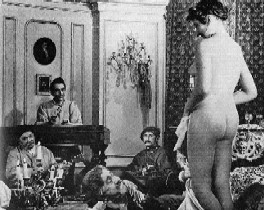
Sex sells. It sells movies. It sells even folklore. So it was just a small step from
Stroheim's masked, half-naked female orchestra and Nubian servants in chastity belts in
The Merry Widow [USA 1925],
much had been deleted before public screening,
to the cossacks in
Par Ordre du Tsar
[At the Order of the Czar, France 1954],
who almost forgot to play their balalaikas while watching a girl strip,
and the nude medieval musicians playing Irish folk music
in Pasolini's
I Racconti di Canterbury
[Canterbury Tales, Italy 1972].
The English nursery rhyme
Here We Go Round the Mulberry Bush
[UK 1967]
became the title of a swinging 60's sex comedy.
I suppose
Mazurka på Sengekanten
(Bedroom Mazurka, Denmark 1970)
wasn't about Polish folk dancing,
whereas Die Wirtin von der Lahn
[The Sweet Sins of Sexy Susan, Austria 1967]
takes inspiration from popular mocking rhymes
from the early 18th century, associated with a certain
inn
at the River Lahn. The original first verse goes:
Es steht ein Wirtshaus an der Lahn.
Da kehren alle Fuhrleut an.
Frau Wirtin sitzt am Ofen,
Die Fuhrleut um den Tisch herum,
Die Gäste sind besoffen.
Most verses were impudent and indecent, ask any German speaking adults for translation, e.g.
Frau Wirtin hat auch einen Arzt,
Der Opernmelodien farzt.
Da ist er Virtuose,
Doch wenn er Wagner blasen soll,
Dann geht es in die Hose.
More or less lewd verses have been recorded by
the Comedian Harmonists
and Will Höhne.
Curt Goetz included
less offending verses concerning a surgeon in the first major German motion picture released after World War II,
Frauenarzt Dr. Prätorius
[Germany 1950]. People flocked to the few theatres in the ruined cities to listen to
the student song "Gaudeamus igitur"
(Let us rejoice),
and the following satirical verse:
Es lebt allhier ein weiser Mann,
Der, was dir fehlt, ergründen kann.
Er tut dich schön sezieren.
Wenn du von dir was wissen willst,
Brauchst du nur zu krepieren.
|
This left films open to censorship and banning by city and state boards until the
early 1950s when eventually granted constitutional protection.)
In 1910, Canadian-born film producer and director
Sidney Olcott
prompted Hollywood to shoot outside the United States.
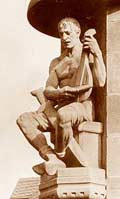 Of Irish ancestry and knowing that in America there was a huge Irish audience, he went to Ireland
to make more than a dozen films on location.
Conway, the Kerry Dancer
[USA 1912] has a telling title. The British production
Rosaleen Dhu [UK 1920], a two hour film,
features an Irish crossroads dancing sequence shot in Kilmacanogue in County Wicklow.
Of Irish ancestry and knowing that in America there was a huge Irish audience, he went to Ireland
to make more than a dozen films on location.
Conway, the Kerry Dancer
[USA 1912] has a telling title. The British production
Rosaleen Dhu [UK 1920], a two hour film,
features an Irish crossroads dancing sequence shot in Kilmacanogue in County Wicklow.
In Erich von Stroheim's
Merry-Go-Round
[USA 1923],
George Siegmann
plays a Viennese brute who forces
Mary Philbin
to continue playing
the hurdy-gurdy while her mother is dying. The story of the dragon slayer Siegfried in Fritz Lang's
Die Nibelungen [Germany 1924]
is told by the minstrel
Volker von Alzey,
played by Bernhard Goetzke.
After Siegfried is slain by his rival Hagen, Goetzke smashes his lyre.
In retrospective, the silent era was rather short.
Sometimes string quartets had been used on the set to put actors in the right mood.
In the theatres, films were accompanied by piano, organ or sometimes a quartet.
Some feature films had even big orchestral accompaniment,
but were naturally restricted to a small number of theatres only.
First attempts on sound films can be dated back to 1895.
In 1907, the first opera movies were produced, so-called photophon or
tonbilder, with the music played from a gramophone.
 Das Lied vom Lieserl [Germany 1909] introduced audiences to the singing and
yodelling of Mirzl Hofer.
Stille Nacht, Heilige Nacht [Germany 1909]
probably features the well-known Christmas song
(-> FW#12).
D.W. Griffith's
Dream Street [USA 1921]
had a single singing sequence. However, Griffith soon stopped using
sound because he thought it was financial suicide, stating:
Only 5 percent of the world
speaks English, so why should I lose 95 percent of my audience?
Das Lied vom Lieserl [Germany 1909] introduced audiences to the singing and
yodelling of Mirzl Hofer.
Stille Nacht, Heilige Nacht [Germany 1909]
probably features the well-known Christmas song
(-> FW#12).
D.W. Griffith's
Dream Street [USA 1921]
had a single singing sequence. However, Griffith soon stopped using
sound because he thought it was financial suicide, stating:
Only 5 percent of the world
speaks English, so why should I lose 95 percent of my audience?
However, by 1925 sound had arrived in the form of radio, and Hollywood
studios tried various innovations to keep their audiences.
Warner Brothers' Don Juan [USA 1926]
utilized the
Vitaphone sound-on-disc process.
Like several other films that followed over
the next year, it had a synchronized instrumental score and some sound effects.
At the premiere, Will Hays,
the chief censor of Hollywood's film industry,
contributed an on-screen introduction in synchronized sound
welcoming the audience to a new era of motion picture.
After that, the Los Angeles Philharmonic Orchestra was filmed playing "Tannhäuser", there was an opera
short, and then the feature film.
On 6th October 1927, Warner Brothers screened The Jazz Singer [USA 1927],
which eventually
changed the course of film history for ever. The feature-length motion picture was
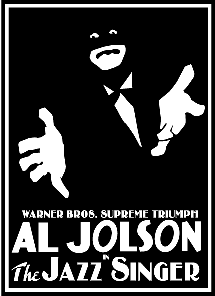 telling the sentimental story of a Jewish boy who becomes a popular cabaret performer,
much to the distress of his father, a cantor in the synagogue. It had
an synchronized musical score with sound effects along with synchronized singing and talking sequences.
In total, the movie had just two minutes of dialogue, the rest was still presented through caption cards.
telling the sentimental story of a Jewish boy who becomes a popular cabaret performer,
much to the distress of his father, a cantor in the synagogue. It had
an synchronized musical score with sound effects along with synchronized singing and talking sequences.
In total, the movie had just two minutes of dialogue, the rest was still presented through caption cards.
The part of the Jewish boy was offered to the singer
Al Jolson,
who had inspired the original Broadway production by Samson Raphaelson in the first place.
Jolson was the most popular vaudeville performer of this era. He used to have
a runway extending out from the stage to be closer to the audience
and he used to stop productions in which he was performing, turn to the audience and ask
them if they would rather hear him sing instead of watching the rest of the play. Most times
Jolson would spend the next hour singing an impromptu concert.
He had filmed a brief musical performance in a short film before,
A Plantation Act [USA 1926].
Jolson, wearing black-face make-up, stands in front of a mural with some
chickens walking around and sings three of his hit songs.
Jolson's first spoken words in The Jazz Singer were: Wait a minute, wait a minute, you ain't heard nothin' yet.
Jolson's character performs seven popular jazz tunes.
His father (tenor Joseph Diskay with
Warner Oland on screen) sings the traditional "Kol Nidre,"
the Jewish prayer recited at the beginning of the Yom Kippur service.
The famous cantor Jossele Rosenblatt,
appearing as himself, sings another important prayer in the Jewish mourning rituals,
the traditional "Kaddish".
Al Jolson continued to make features for Warners, similar in style to The Jazz Singer.
For the majority of movie audiences, The Singing Fool [USA 1928]
became their first experience
with a talking film because
only few movie theatres had been equipped with a sound system the year before.
The Singing Fool held the record for box-office attendance until broken by
Gone with the Wind [USA 1939].
Its signature tune, "Sonny Boy," became the first American record to sell one million copies.
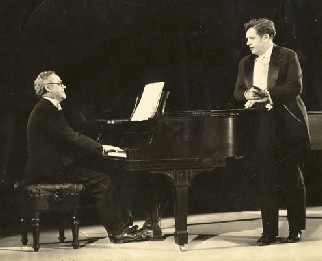 Within a year, Hollywood would be producing almost exclusively sound films.
MGM's The Broadway Melody
[USA 1929] became the
first musical score written specifically for the screen.
Within a year, Hollywood would be producing almost exclusively sound films.
MGM's The Broadway Melody
[USA 1929] became the
first musical score written specifically for the screen.
The swan song of the silent era would be uttered more than a decade later,
by no other than slapstick star
Charlie Chaplin.
The original ending of
The Great Dictator [USA 1940] had
German Wehrmacht soldiers discarding their weapons and uniting in a kind of folk dancing.
Since the sequence was not working, Charlie Chaplin would abandon it and he
delivered instead his famous speech for peace, freedom and sanity.
In the first years of sound productions it seemed that every other film was a musical with advertising
reading: All Talking! All Singing! Hollywood lured many Broadway stars to the screen.
Unfortunatly some film stars were not phonogen enough.
Screen lover John Gilbert,
who employed a balalaika orchestra and servants
dressed up as cossacks in the 1920s, had to take speech lessons,
but his light tenor voice did not match his male screen persona.
A Star Is Born [USA 1937]
is inspired by Gilbert, who died in 1936, his health severely damaged by alcoholism.
See also Billy Wilder's
Sunset Boulevard
[USA 1950], where silent-film star Gloria Swanson
plays a former silent-film star who has faded into obscurity.
The pale moon was rising above the green mountain
The sun was declining beneath the blue sea
When I strayed with my love to the pure crystal fountain
That stands in beautiful vale of Tralee
|
Song O' My Heart
[USA 1929] was a vehicle designed especially for Irish tenor
John McCormack
to appear in a starring role.
In its original form Song O' My Heart had full dialogue on the soundtrack along
with the musical numbers. For foreign release, however, the dialogue in English was
replaced by a continuous musical score and caption cards.
The film is unique for an uninterrupted concert sequence that replicates the performance
which McCormack gave all over the world. He sings a cross-section of his repertoire,
including a couple of 19th century Irish parlour songs such as "The Rose of Tralee,"
which inspired Ireland's annually held beauty contest.
The song is usually credited to C. Mordaunt Spencer and Charles William Glover,
but the Rose of Tralee festival claims it was written by a wealthy Protestant who fell in love
with a poor Catholic maid in his service.
All' mein' Gedanken, die ich hab', die sind bei dir
Du auserwählter ein'ger Trost, bleib' stets bei mir
Du, du, du sollst an mich gedenken
Hätt' ich aller Wünsch Gewalt
Von dir wollt' ich nicht wenken
|
McCormack sings the German minnelied "All mein Gedanken," which had been
published at Lochheim in Lower Bavaria in 1460.
He also does a version of the French
"Plaisir d'amour"
(The Joys of Love) from the late 18th century.
Joan Baez's
version from 1968 transformed it from a classical into a folk song,
it was furthermore rewritten as a pop song for
Blue Hawaii
[USA 1961],
starring Elvis Presley.
since then called "Can't Help Falling in Love" it has been recorded from
Bob Dylan
to Luka Bloom
and appeared on a couple of film soundtracks.
One morning early I walked forth
by the margin of Lough Leane
The sunshine dressed the trees in green
and summer bloomed again
I left the town and wandered on
through fields all green and gay
And whom should I meet but a colleen sweet
at the dawning of the day
|
McCormack also made a cameo appearance as himself in a concert sequence unrelated
to the story in the first British technicolor film
Wings of the Morning [UK 1936],
which also features gypsies travelling in horse-drawn caravans and dancing round the campfire.
 McCormack sings "Believe Me If All Those Endearing Young Charms"
by Irish poet and songwriter
Thomas Moore,
"Killarney" by Irish opera singer and composer
Michael W. Balfe,
and the traditional Irish "The Dawning of the Day" (Fainne Geal an Lae).
Patrick Kavanagh
used the tune for his song "Raglan Road" in 1946,
popularized by the great
Luke Kelly
of the Dubliners
in the 1960s
(-> FW#23)
and recorded all over and over again (e.g. ->
FW#8,
FW#18,
FW#31,
FW#32).
McCormack sings "Believe Me If All Those Endearing Young Charms"
by Irish poet and songwriter
Thomas Moore,
"Killarney" by Irish opera singer and composer
Michael W. Balfe,
and the traditional Irish "The Dawning of the Day" (Fainne Geal an Lae).
Patrick Kavanagh
used the tune for his song "Raglan Road" in 1946,
popularized by the great
Luke Kelly
of the Dubliners
in the 1960s
(-> FW#23)
and recorded all over and over again (e.g. ->
FW#8,
FW#18,
FW#31,
FW#32).
A close friend of McCormack, Irish balladeer
Delia Murphy
was one of the first singers to put genuine folk music on the screen.
Delia Murphy was the first popular singer of traditional ballads recorded in Ireland
and is generally credited with laying the groundwork for the Irish folk revival.
Though McCormack would joke that there were 100 things that went to make a singer,
Delia had 99 of them, and the only thing she lacked was a voice.
A projectionist at Killarney's Casino cinema in the south west of Ireland did remember that Delia's records were
played before showing films in the late 1930s and early 1940s, her recording of
"The Spinning Wheel" being the most popular. Consequently she was asked to take a part in
Island Man [Ireland 1938],
which was filmed on location on the Blasket Islands off the west coast of Ireland
(-> FW#28).
In one of the interior scenes, the house céilí, she sings
"On the Deck of Paddy Lynch's Boat", a translation of the Gaelic song
"Ar an loing seo Paidí Loingsigh."
Delia Murphy had an amusing story about
Robert Flaherty's
documentary Man of Aran
[UK 1934]. The Aranmen came down to London for the studio shots:
|
They were very lonesome, and they were making this mash [for whiskey]
in the house over two or three days. The smell was very powerful,
and they noticed this big policeman walking up and down. So they
got a bit nervous. Anyway, he came back the next day and eventually
he walked up to the door, and they thought the game was up. But he
asked, Is the shtuff near ready? He was a West of Ireland man,
and he'd been waiting patiently.
|
American sex symbol Mae West
starred as a bawdy bar room singer who sang a cleansed version of
"Frankie and Johnny."
Nevertheless,
She Done Him Wrong [USA 1933],
based on a successful Broadway play written by Mae West herself,
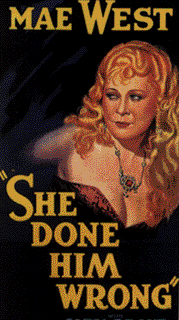 was one of the films that caused the foundation of the
Catholic Legion of Decency
and their campaign for the purification of the cinema,
and was actually locked away after its initial
screening until the mid 1950s.
was one of the films that caused the foundation of the
Catholic Legion of Decency
and their campaign for the purification of the cinema,
and was actually locked away after its initial
screening until the mid 1950s.
Frankie was a good woman, ev'rybody knows,
Every time she gave Johnny a hundred dollar bill,
He'd spend it on those parlour house who'es,
He was her man, but he done her wrong.
|
The ballad "Frankie and Johnny"
tells the story of a woman who finds her man cheating on her and shoots him dead.
It has probably been inspired by the black dancer Frankie Baker who shot her lover
in St. Louis, Missouri, in 1899.
In 1939, Frankie Baker would sue Paramount Pictures and Mae West wanting part
of the proceeds from the film.
The tune of "Frankie and Johnny" has been used in the
Merrie Melodies
cartoons by Warner Brothers as the leitmotif for a flashy and tawdry woman.
Recordings have been made by singers as diverse as
Johnny Cash
(-> FW#25,
FW#27,
FW#29),
Lonnie Donegan
(-> FW#24)
and Jimmie Rodgers
(-> FW#26,
FW#31,
FW#31).
The basic story has been the inspiration for at least four feature films.
The climax of
Robert Altman's
A Prairie Home Companion
[USA 2006] is an
improvisatory rendition by country singer
Lindsay Lohan.
Joseph Green,
a Polish-born Jew who emigrated to the United States in 1924 and had a walk-on part
in The Jazz Singer, made four Yiddish language films between 1936 and 1939.
Yidl mitn Fidel [Yidl with his Fiddle, Poland/USA 1936]
became a huge success in Poland and among the Jewish community in the US.
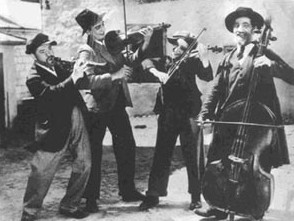 The film was shot on location in Kazimierz, Poland, including
footage of shtetl life before the Nazi invasion and the Holocaust.
Its musical score was composed by
Abe Ellstein,
one of the leading composers in New York City's Jewish theatre scene,
and the lyrics to the songs were written by Yiddish poet and playwright
Itzik Manger.
The film was shot on location in Kazimierz, Poland, including
footage of shtetl life before the Nazi invasion and the Holocaust.
Its musical score was composed by
Abe Ellstein,
one of the leading composers in New York City's Jewish theatre scene,
and the lyrics to the songs were written by Yiddish poet and playwright
Itzik Manger.
The story follows an impoverished man and his
daughter (Molly Picon),
who decide to become klezmorim, travelling Jewish musicians.
Because he is concerned about the misfortunes that can befall a teenage girl,
she hides her sex and disguises herself as a boy. Most interesting is an Eastern European wedding scene.
An old-world Jewish wedding was a multi-day event shifting in mood from meditative
introspection, the rituals of seating and veiling the bride
and reducing her to tears, to ecstatic dancing. The entire event was presided over by the
wedding-jester, known as badkhn, who worked closely with the klezmorim to guide
the emotions of the participants.
Molly Picon, who was actually 38 at the time of filming, was one of the most famous
stars on stage. As the Yiddish theatre faded, Molly Picon began to perform
in English-language productions. She portrayed Yente the Matchmaker in the
film adaptation of the Broadway hit
Fiddler on the Roof
[USA 1971].
Es wird a Wein sein und mir wer'n nimmer sein
D'rum g'niaß ma 's Leb'n so lang's uns g'freut
'S wird schöne Maderln geb'n und wir werd'n nimmer leb'n,
D'rum greif ma zua, g'rad is's no Zeit
|
German actor Willi Forst
had his breakthrough by playing a young pianist on a transatlantic liner,
known as the RMS Titanic.
Atlantic [Germany/UK 1929]
had been filmed simultaneously as a silent movie and English and French language versions.
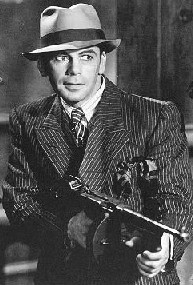 While the ocean liner is sinking, Forst remains seated at the piano and is humming a
19th century song from Vienna's wine taverns. Much more moving than a rather un-historical Riverdance
sequence in a certain
Hollywood blockbuster
from the 1990s.
While the ocean liner is sinking, Forst remains seated at the piano and is humming a
19th century song from Vienna's wine taverns. Much more moving than a rather un-historical Riverdance
sequence in a certain
Hollywood blockbuster
from the 1990s.
Indeed, sound allowed for dramatic effects. Remember
Paul Muni
as a Chicago mobster
in Howard Hawks'
Scarface [USA 1932],
who has a love for opera and is always whistling an aria from the tragic opera
"Lucia di Lammermoor"
by Gaetano Donizetti
before shooting one of his victims.
In Jean Renoir's
La Chienne [The Bitch, France 1931],
Michel Simon,
who used to say that he was born in 1895 and, as misfortune never comes singly, cinema was born the same year,
surprises his screen lover with another man and kills them both with a
letter opener. At the same time people gather before the house
listening to romantic songs from two busking musicians.
The scene ends with the camera observing the murder,
slowly pulling away from the window towards the gathering crowd,
and - the music still continues - approaching the front door of the house.
Michel Simon left, but it was only a beginning.
Keep up with the story of Folk Music on the Silver Screen in the next FolkWorld issue!
Photo Credits:
(1) Mae Wong with sanxian;
(2) Fatima's Dance;
(3) Balalaika Orchestra in Par ordre du Tsar;
(4) Volker von Alzey sculpture @ Worms (destroyed in WW2);
(5) Mirzl Hofer;
(6) The Jazz Singer;
(7) John McCormack in Song O' My Heart;
(8) Delia Murphy;
(9) Mae West in She Done Him Wrong;
(10) Molly Picon and klesmorim in Yidl mitn Fidel;
(11) Paul Muni
in Scarface
(all unknown).
© The Mollis - Editors
of FolkWorld; Published 02/2008
All material published in FolkWorld is © The
Author via FolkWorld. Storage for private use is allowed and welcome. Reviews
and extracts of up to 200 words may be freely quoted and reproduced, if source
and author are acknowledged. For any other reproduction please ask the Editors
for permission. Although any external links from FolkWorld are chosen with greatest care, FolkWorld and its editors do not take any responsibility for the content of the linked external websites.
FolkWorld - Home of European Music

Layout & Idea of FolkWorld © The Mollis - Editors of FolkWorld
 presentation featured ten short films,
each about 17 meters long, which runs approximately 38 to 49 seconds.
Their actualités such as
La Sortie de l'Usine Lumière à Lyon [Exit from the Lumière Factory in Lyon, France 1895]
were rudimentary documentaries, while the slapstick of
L'Arroseur Arrosé
[The Gardener or the Sprinkler Sprinkled, France 1895] anticipated the comedy film.
presentation featured ten short films,
each about 17 meters long, which runs approximately 38 to 49 seconds.
Their actualités such as
La Sortie de l'Usine Lumière à Lyon [Exit from the Lumière Factory in Lyon, France 1895]
were rudimentary documentaries, while the slapstick of
L'Arroseur Arrosé
[The Gardener or the Sprinkler Sprinkled, France 1895] anticipated the comedy film.


 Of Irish ancestry and knowing that in America there was a huge Irish audience, he went to Ireland
to make more than a dozen films on location.
Of Irish ancestry and knowing that in America there was a huge Irish audience, he went to Ireland
to make more than a dozen films on location.
 Das Lied vom Lieserl [Germany 1909] introduced audiences to the singing and
yodelling of Mirzl Hofer.
Das Lied vom Lieserl [Germany 1909] introduced audiences to the singing and
yodelling of Mirzl Hofer.
 telling the sentimental story of a Jewish boy who becomes a popular cabaret performer,
much to the distress of his father, a cantor in the synagogue. It had
an synchronized musical score with sound effects along with synchronized singing and talking sequences.
In total, the movie had just two minutes of dialogue, the rest was still presented through caption cards.
telling the sentimental story of a Jewish boy who becomes a popular cabaret performer,
much to the distress of his father, a cantor in the synagogue. It had
an synchronized musical score with sound effects along with synchronized singing and talking sequences.
In total, the movie had just two minutes of dialogue, the rest was still presented through caption cards.
 Within a year, Hollywood would be producing almost exclusively sound films.
MGM's
Within a year, Hollywood would be producing almost exclusively sound films.
MGM's  McCormack sings "Believe Me If All Those Endearing Young Charms"
by Irish poet and songwriter
Thomas Moore,
"Killarney" by Irish opera singer and composer
Michael W. Balfe,
and the traditional Irish "The Dawning of the Day" (Fainne Geal an Lae).
Patrick Kavanagh
used the tune for his song "Raglan Road" in 1946,
popularized by the great
Luke Kelly
of the Dubliners
in the 1960s
(-> FW#23)
and recorded all over and over again (e.g. ->
FW#8,
FW#18,
FW#31,
FW#32).
McCormack sings "Believe Me If All Those Endearing Young Charms"
by Irish poet and songwriter
Thomas Moore,
"Killarney" by Irish opera singer and composer
Michael W. Balfe,
and the traditional Irish "The Dawning of the Day" (Fainne Geal an Lae).
Patrick Kavanagh
used the tune for his song "Raglan Road" in 1946,
popularized by the great
Luke Kelly
of the Dubliners
in the 1960s
(-> FW#23)
and recorded all over and over again (e.g. ->
FW#8,
FW#18,
FW#31,
FW#32).
 was one of the films that caused the foundation of the
was one of the films that caused the foundation of the
 The film was shot on location in Kazimierz, Poland, including
footage of shtetl life before the Nazi invasion and the Holocaust.
Its musical score was composed by
The film was shot on location in Kazimierz, Poland, including
footage of shtetl life before the Nazi invasion and the Holocaust.
Its musical score was composed by
 While the ocean liner is sinking, Forst remains seated at the piano and is humming a
19th century song from Vienna's wine taverns. Much more moving than a rather un-historical Riverdance
sequence in a certain
Hollywood blockbuster
from the 1990s.
While the ocean liner is sinking, Forst remains seated at the piano and is humming a
19th century song from Vienna's wine taverns. Much more moving than a rather un-historical Riverdance
sequence in a certain
Hollywood blockbuster
from the 1990s.
